Newsletter: In praise of an uncensored arts education
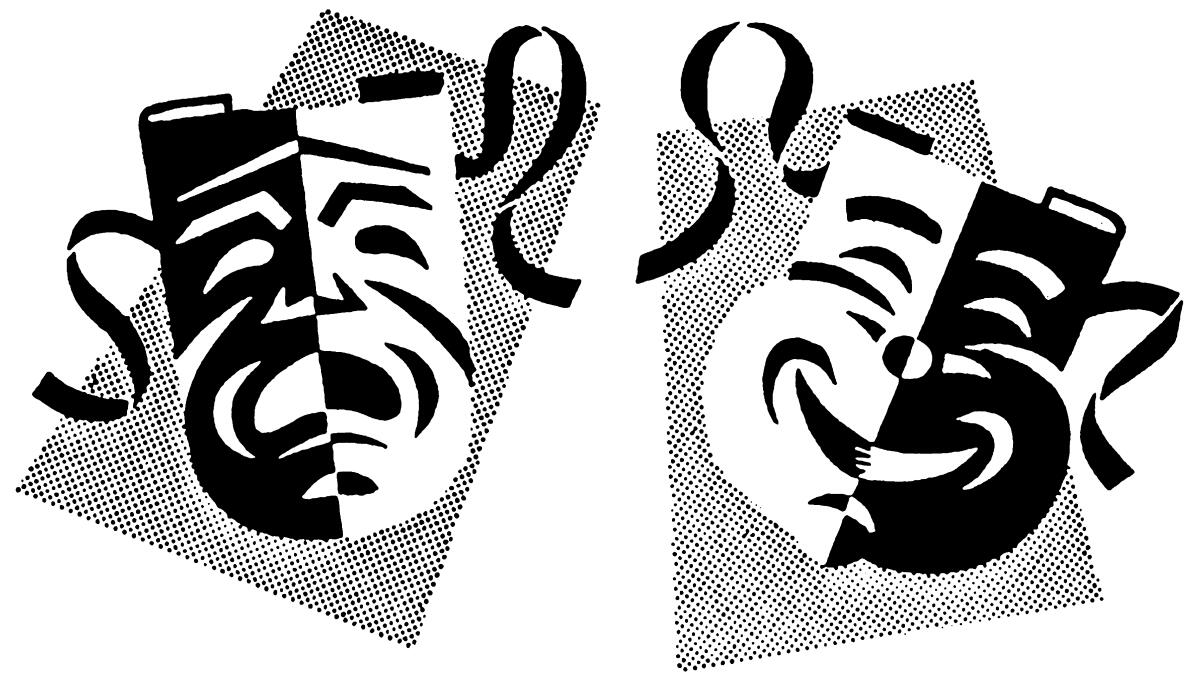
- Share via
Politicians and pundits have plenty to say these days about what children should and shouldn’t learn. But what do kids think? If I listen to my own daughters, the answer is: They want to absorb it all — the good, the bad, the ugly and everything in between. And as a parent, I want to widen their world, not narrow it.
I’m arts and culture reporter Jessica Gelt, filling in for Carolina Miranda, and my 20th century arts education is much on my mind as the nature and meaning of what we teach our kids in school becomes the fraught culture war du jour.
‘Savage in Limbo’
In the 1990s, when I was a freshman in high school, I was cast as April White in John Patrick Shanley’s play “Savage in Limbo.” The action takes place inside a dive bar in the Bronx, and when it opens, April is asleep on the bar. The bartender wakes her and pours her another drink.
For the record:
4:41 p.m. April 25, 2022An earlier version of this article said Collis P. Huntington was behind L.A.’s landmark Huntington Library. It was his nephew, Henry E. Huntington.
The play, written in 1984, is littered with F-bombs and plumbs the depths of the lives of characters who feel they have reached dead ends and failed miserably in their early 30s. It is rich and tragic and tender. April is perhaps the saddest case in the whole play — a lost alcoholic who was supposed to become a nun but ended up a fixture in the bar. She delivers a soul-crushing monologue about her problem.
“You drink and you drink,” she says. “And the more you drink, the more it goes through this one part of you, just this one part of you. And the more it goes through, the more it kills this part till that part’s dead.”
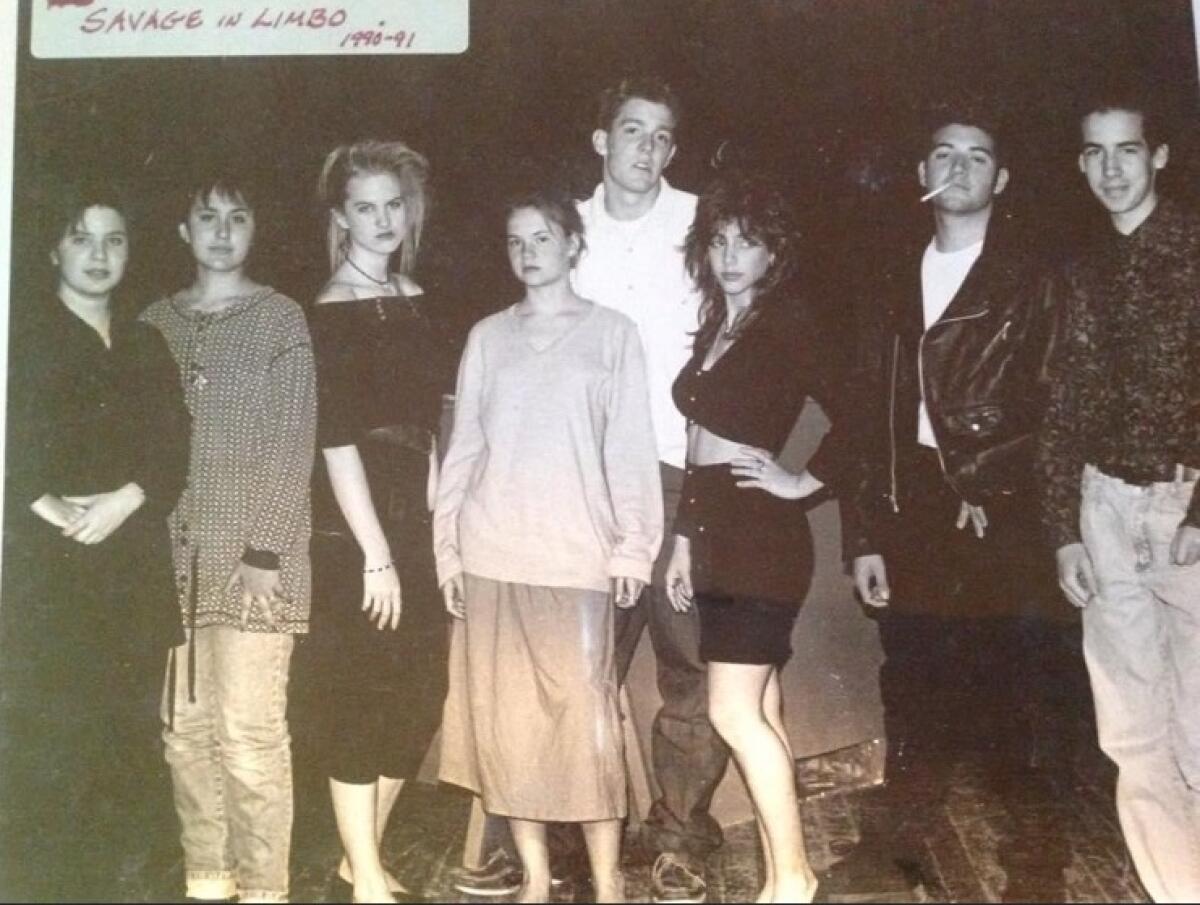
Those were heavy lines to learn at 14, but decades later, I can still remember how it felt to deliver them. I vividly recall sitting on a barstool onstage, sweating through my pancake makeup under the bright lights — a menthol Virginia Slim between my fingers, my other hand absent-mindedly twisting the stem of a glass snifter.
This play wasn’t produced by a local theater company — it was put on by my public school, Tucson High Magnet School for the Arts. It was one of the best, most fulfilling experiences of my young life, and I am certain that there is absolutely no way on earth such a play would be staged by an American public high school in 2022.
In fact, I believe that most of the teachers who presided over my arts education in high school would today be fired, chastised or otherwise canceled. Not because they were bad teachers — they were, to my mind, brilliant teachers — but because they let their students take the lead on what kind of art they made and participated in.
I choreographed dances to Ministry in nude bodysuits while snippets of Yeats’ poem “The Second Coming” droned in the background; I took black-and-white portraits of my friends naked and wrapped in Saran wrap as a way to express the baffling confines of my own teen angst; I delivered a fictional monologue about having an abortion for a school variety show; and I created a zine called Strabismal featuring poems students submitted, including those with titles like “The Copulation Dance,” “Old Piss” and “Homophobia Sucks.”
Subtle and refined these bouts of expression were not. Cathartic and transformative, though? Absolutely.
Teenagers, despite what recent culture wars would have you believe, can and want to handle challenging thoughts and material. Whether it be acting, dancing, painting, filming or writing, the arts allow young minds to understand and process the trauma and chaos of life without living that trauma themselves. And let’s not forget the loveliness inherent in art, which shines through in spite of — or perhaps because of — the pain it often illuminates.
The current political and pundit-driven trend of minimizing young people’s exposure to art deemed controversial, mature or risqué entirely misses the point of arts education. The arts allow us to travel to places we wouldn’t otherwise be able to go — to meet characters we wouldn’t otherwise meet, think thoughts we wouldn’t otherwise have, explore ideas we might otherwise be too frightened or intimidated to delve into.
In high school, I spent four nights onstage living the life of a depressed woman waylaid in a down-and-out bar. Long enough to know that wasn’t where I wanted to one day live myself. Long enough to develop empathy and compassion for those who might find themselves in such a space.
Long enough to feel the prickle of chills down my spine at the exhilarating thought that I was a growing, independent girl in a tumultuous, confusing — and breathtakingly beautiful — world of possibility.
Make the most of L.A.
Get our guide to events and happenings in the SoCal arts scene. In your inbox every Monday and Friday morning.
You may occasionally receive promotional content from the Los Angeles Times.
Design time
Our very own arts, architecture and urban design columnist, Carolina Miranda, cannot be stopped. One minute you think you know where she is, the next minute she’s tweeting about a churro cart in San Diego. She tells you where to score the tasty treats in her illuminating and comprehensive guide to San Diego’s new architecture, including a custom geocoded map of various structures of interest.
These include the nine-story San Diego Central Library, “capped by a metallic dome, with half a million square feet of space, including an auditorium, a cafe, a gallery and a rooftop sculpture garden”; the magnificent Salk Institute (“Can a scientific building feel like a religious experience?” Miranda asks. And answers, “Yes it can”); and the mesmerizing, orb-like majesty of the Rady Shell at Jacobs Park, of which she writes, “The $85-million project also includes a dramatic tensile canopy bandshell that resembles, from certain angles, the protective exoskeleton of a gargantuan sea creature.”
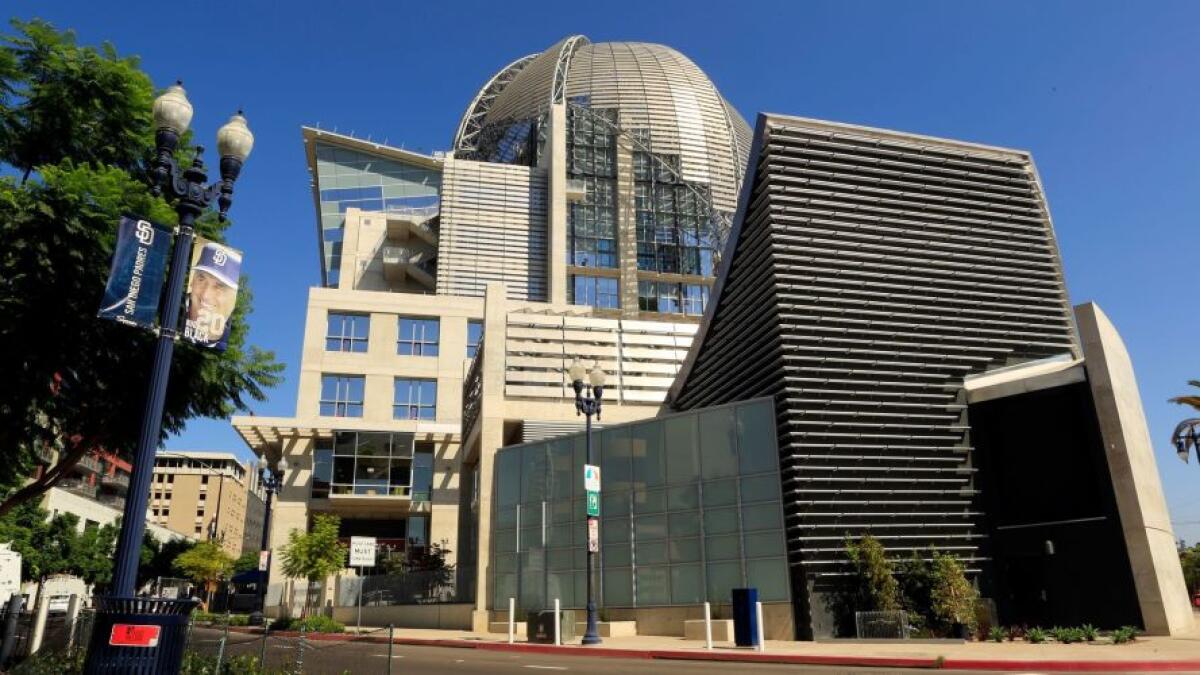
Want to know more about the famous names behind L.A.’s most noteworthy and historic landmarks? Times columnist Patt Morrison breaks down the the history and stories of Charles Lummis (Lummis House), Norton Simon (of the Norton Simon Museum) and Henry E. Huntington (whose gardens and museums attract guests from around the world).
Classical notes
Classical music critic Mark Swed had an extremely busy week reviewing three SoCal operas: two new ones, “Everything Rises,” which was commissioned by the UC Santa Barbara Arts & Lectures series, and Du Yun’s “In Our Daughter’s Eyes” at REDCAT; and a collaboration between Gustavo Dudamel and the Los Angeles Philharmonic and Deaf West Theatre, of Beethoven’s “Fidelio.”
“Everything Rises,” Swed explains, is “a personal project by Davóne Tines and violinist Jennifer Koh, with an all-BIPOC team, that experimentally explores with ancestry and inclusivity.” The show is anticipated to move on to New York.
“In Our Daughter’s Eyes,” he writes, was created by the Pulitzer Prize-winning Du Yun for baritone Nathan Gunn, whom Swed calls “terrific.”
“The opera was his own effort to become a more creative performer and, as a father of five and a recovering alcoholic, has elements of his own personality and story. He jumps into each scene, busy as a bee.”
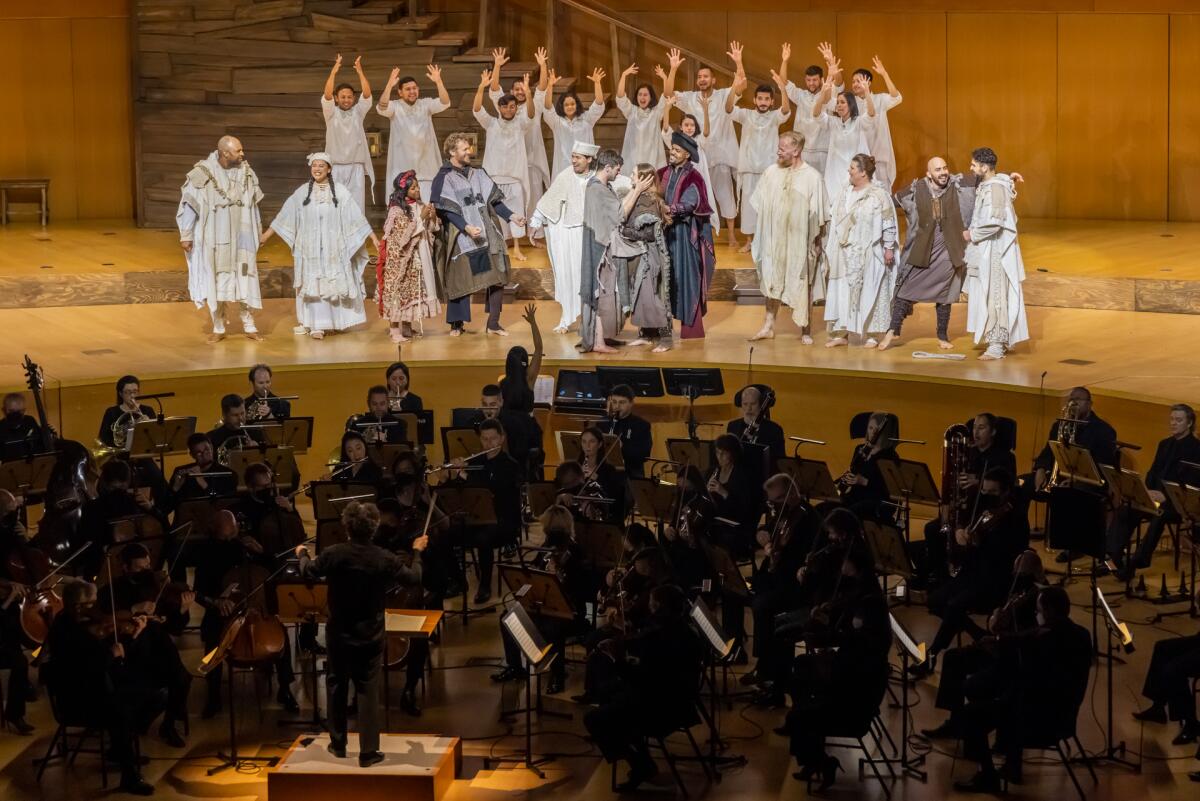
Swed begins his review of “Fidelio” by explaining that the opera is dramatically flawed and that the legendary composer anguished over it perhaps longer than any of his other great works. This, Swed conjectures, opens it up to an infinite number of interpretations, the most recent of which Swed found extraordinary.
“Now, though, we have something altogether new and radical in the annals of opera. In an extraordinary production last week at Walt Disney Concert Hall, Gustavo Dudamel and the Los Angeles Philharmonic, with Deaf West Theatre, liberated not only ‘Fidelio’ but also transformed the act of listening. Liberation on the lyric stage has never looked like this.”
Swed caps off his own extraordinary week with an appreciation of Romanian pianist Radu Lupu, who died Sunday.
“On hearing of Lupu’s passing, I put on his recordings of Brahms’ late piano pieces, Opp. 117, 118 and 119, which he recorded as a young man. I was instantly, yes, transported. It is absolutely true that his depth, his capacity to impart beauty and a meaning, goes beyond understanding. If truth, in fact, has a sound, this is it,” writes Swed.
Enjoying this newsletter? Consider subscribing to the Los Angeles Times
Your support helps us deliver the news that matters most. Become a subscriber.
On the walls
Arts contributor Leigh-Ann Jackson takes in two L.A. art installations of New York-based artist Derek Fordjour’s work. The first is a 5,400-square-foot mural called “Sonic Boom” on the facade of downtown’s Museum of Contemporary Art, which Jackson describes as possessing “a sense of both exuberance and pageantry.” The second is on display in an exhibition at David Kordansky Gallery, where visitors will find work that displays “facets of African American culture that are steeped in tradition — from the widely celebrated to the obscure to the surreal.”
Jackson also conducted a fascinating Q&A with artist Gary Simmons, whose exhibition “Remembering Tomorrow,” a collection of drawings, paintings and sculptures, is featured at Hauser & Wirth Los Angeles through May 22. Simmons uses a chalkboard as one of his mediums and familiar characters to pose provocative questions about memory. “That’s why I feel that work is so powerful; it creates that sort of uncertainty,” he tells Jackson. “There’s those slippages and traces that exist that call on the viewer to complete the visual circuitry and the conceptual circuitry — their relationship to those images, whether it be guilt or horror or whatever it is. The work forces you to go down certain parts of memory lane.”
Carolina Miranda uses her column to further explore how SoFi Stadium’s plan for its public art program left Black artists in limbo, with several pieces remaining to be installed and no timeline in place.
“This included a site-specific land piece by prominent African American sculptor Maren Hassinger,” writes Miranda, who then details frustrations expressed by Hassinger in a letter to the city of Inglewood written by Hassinger’s rep, New York-based art dealer Susan Inglett.
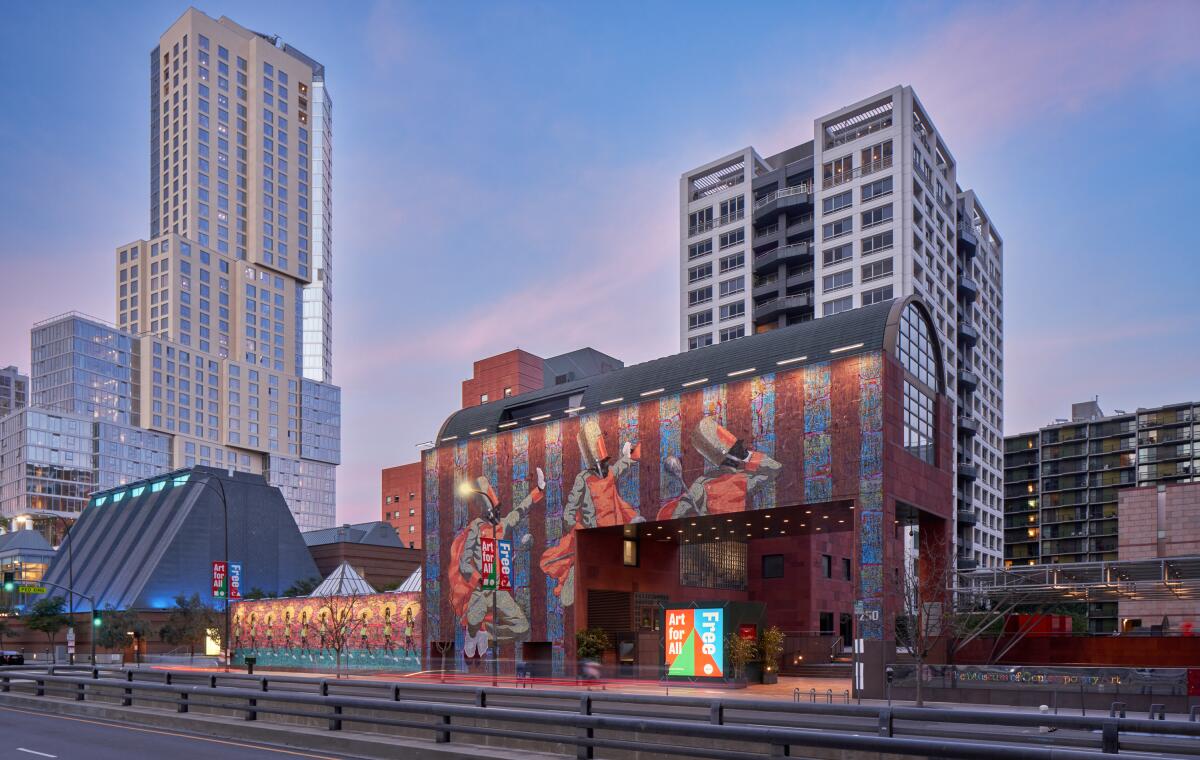
On and off the stage
I spent a lovely morning interviewing actress Calista Flockhart about her upcoming role as Martha in the Geffen Playhouse production of Edward Albee’s classic 1962 play, “Who’s Afraid of Virginia Woolf?” Flockhart talked about what it’s like returning to the stage after two decades, and why she chose to forgo an insane work schedule to spend time raising her son, Liam, who is now away at college.

“Whenever I did a play, I was usually the ingénue and one of the youngest people in the cast. And now I’m definitely the oldest person in the cast,” she told me, adding: “And that’s really fun and exciting. I could never play Martha without all the life experience. So it feels pretty wonderful.”
I also got to spend quality time with her sweet pit bull, Coco, who would not leave me alone until I gave her a really good belly rub.
Essential happenings
Our always on-the-mark Matt Cooper is back this week with six fabulous arts options for your weekend pleasure. Los Angeles Ballet, writes Cooper, “is staging two L.A. premieres, Annabelle Lopez Ochoa’s ‘Bloom’ and Christopher Wheeldon’s ‘Ghosts’ — plus composer Igor Stravinsky and choreographer George Balanchine’s classic collaboration ‘Apollo.’”
Also on offer: “The Sound of Music” at La Mirada Theatre for the Performing Arts; TCM Classic Movies Festival at TCL Chinese Theatre; and a Pittance Chamber Music presentation featuring “soprano Elissa Johnston and members of the Los Angeles Opera Chorus in a performance of the complete love songs of 19th century German composer Johannes Brahms, with L.A. Opera conductors Grant Gershon and Jeremy Frank sharing a bench for piano four hands.”
Passages
The exuberant rock ‘n’ roll artist Cynthia Plaster Caster, famous for creating plaster casts of celebrities’ erect penises, is dead at 74.
In other news
— Faculty at the University of Florida created an aria in response to the provost asking faculty to “reconsider” the use of certain terms, including “systemic change,” “power and privilege” and “micro-aggression.” The music is based, in part. on compositions by the 20th century Russian composer Dmitri Shostakovich.
— File this under “my worst nightmare after a cocktail”: A hotel in Germany uses 3-D carpets to prevent guests from running in the halls.
— ARTnews has ranked the 10 best national pavilions at the 2022 Venice Biennale. France’s Zineb Sedira takes first place.
— A court case about a painting by Camille Pissarro stolen by a Nazi from a German Jew has been remanded by the Supreme Court back to court in California for more proceedings.
And last but not least ...
The Tony Awards this week sent out a letter to potential ticket buyers that included this juicy tidbit: “The Tony Awards has a strict no violence policy. In the event of an incident, the perpetrator will be removed from the event immediately.”
Clearly, the warning is reference to Will Smith’s infamous Oscar slap of Chris Rock, but really? Lots to unpack there for theater geeks everywhere.
The biggest entertainment stories
Get our big stories about Hollywood, film, television, music, arts, culture and more right in your inbox as soon as they publish.
You may occasionally receive promotional content from the Los Angeles Times.




